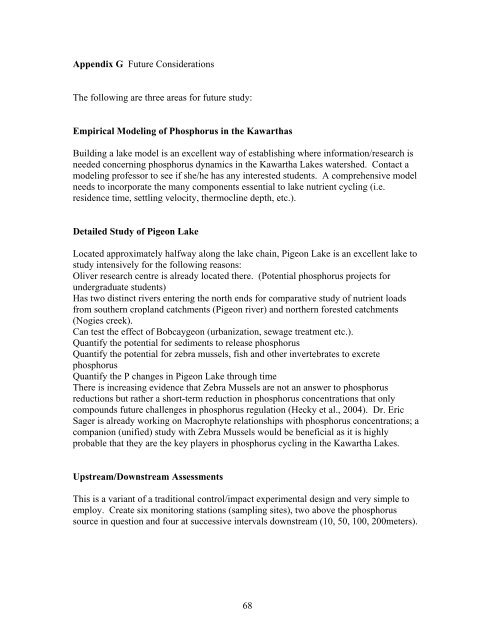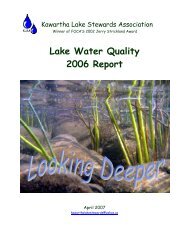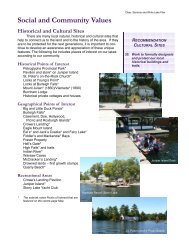Phosphorus and the Kawartha Lakes - Lakefield Herald
Phosphorus and the Kawartha Lakes - Lakefield Herald
Phosphorus and the Kawartha Lakes - Lakefield Herald
Create successful ePaper yourself
Turn your PDF publications into a flip-book with our unique Google optimized e-Paper software.
Appendix G Future Considerations<br />
The follow ing are three areas for future study:<br />
Empirical Modeling of <strong>Phosphorus</strong> in <strong>the</strong> <strong>Kawartha</strong>s<br />
Building a lake model is an excellent way of establishing where information/research is<br />
needed concerning phosphorus dynamics in <strong>the</strong> <strong>Kawartha</strong> <strong>Lakes</strong> watershed. Contact a<br />
modeling professor to see if she/he has any interested students. A comprehensive model<br />
needs to incorporate <strong>the</strong> many components essential to lake nutrient cycling (i.e.<br />
residence time, settling velocity, <strong>the</strong>rmocline depth, etc.).<br />
Detailed Study of Pigeon Lake<br />
Located approximately halfway along <strong>the</strong> lake chain, Pigeon Lake is an excellent lake to<br />
study intensively for <strong>the</strong> following reasons:<br />
Oliver research centre is already located <strong>the</strong>re. (Potential phosphorus projects for<br />
undergraduate students)<br />
Has two distinct rivers entering <strong>the</strong> north ends for comparative study of nutrient loads<br />
from sou<strong>the</strong>rn cropl<strong>and</strong> catchments (Pigeon river) <strong>and</strong> nor<strong>the</strong>rn forested catchments<br />
(Nogies creek).<br />
Can test <strong>the</strong> effect of Bobcaygeon (urbanization, sewage treatment etc.).<br />
Quantify <strong>the</strong> potential for sediments to release phosphorus<br />
Quantify <strong>the</strong> potential for zebra mussels, fish <strong>and</strong> o<strong>the</strong>r invertebrates to excrete<br />
phosphorus<br />
Quantify <strong>the</strong> P changes in Pigeon Lake through time<br />
There is increasing evidence that Zebra Mussels are not an answer to phosphorus<br />
reductions but ra<strong>the</strong>r a short-term reduction in phosphorus concentrations that only<br />
compounds future challenges in phosphorus regulation (Hecky et al., 2004). Dr. Eric<br />
Sager is already working on Macrophyte relationships with phosphorus concentrations; a<br />
companion (unified) study with Zebra Mussels would be beneficial as it is highly<br />
probable that <strong>the</strong>y are <strong>the</strong> key players in phosphorus cycling in <strong>the</strong> <strong>Kawartha</strong> <strong>Lakes</strong>.<br />
Upstream/Downstream Assessments<br />
This is a variant of a traditional control/impact experimental design <strong>and</strong> very simple to<br />
employ. Create six monitoring stations (sampling sites), two above <strong>the</strong> phosphorus<br />
source in question <strong>and</strong> four at successive intervals downstream (10, 50, 100, 200meters).<br />
68





